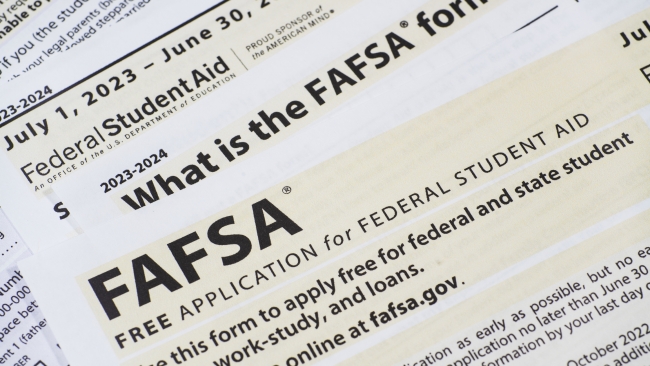You have /5 articles left.
Sign up for a free account or log in.

One-third of students say their institution has communicated somewhat or very poorly with them about changes to the FAFSA, and a similar portion of students say their institution has communicated somewhat or very well.
Richard Stephen/iStock/Getty Images Plus
Higher education leaders have worked tirelessly over the past five months to recover from the Department of Education’s delayed and error-ridden rollout of the new Free Application for Federal Student Aid form (FASFA), but one in five current students say they’re not aware of changes to FAFSA, or are unconcerned about the issues.
New Student Voice survey data, collected by The Generation Lab for Inside Higher Ed, found 21 percent of college students don’t know about the new FAFSA requirements or were not aware of changes to the form—and half of these students self-identify as being on federal financial aid.
Among those who do know about the new requirements, 18 percent say they are “not at all concerned” and an additional 14 percent don’t expect to receive financial aid, so they didn’t fill out a FAFSA.
The survey was fielded April 28 to April 30 from a sample of 1,206 current college students at public and private nonprofit institutions (83 percent four-year and 17 percent two-year) from around the country, with a margin of error of +/- 2.8 percentage points.
As financial aid officers scramble to provide incoming students with their packets, experts warn returning students could be thrown off by the lack of information or changes to their financial aid offers due to FAFSA.
“The same way we leverage FAFSA and try to remove barriers to get them enrolled, we have to keep that same energy to keep them enrolled,” says Jhenai Chandler, senior director of college completion at The Institute for College Access and Success (TICAS). “Just like FAFSA is an enrollment tool, it’s also a retention tool.”
The risk: Data from Trellis Strategies, Sallie Mae and Gallup and the Lumina Foundation find financial challenges are one of the primary concerns among college students, and more so for those who have seriously considered stopping out.
In the Student Voice survey, those who receive financial aid are more likely to say they are concerned about FAFSA this year. Six in 10 students who self-identify that they receive federal aid say they’re somewhat or very concerned about the FAFSA rollout, and 49 percent of low-income students (those coming from families that make less than $50,000) hold some level of concern.
The lack of awareness around the new FAFSA doesn’t shock MorraLee Keller, senior director of strategic programming at the National College Attainment Network, because not every student fills out their own FAFSA, working with their parents to provide data, she says.
However, many students depend on their financial aid packages to determine their enrollment status, and Chandler worries that a lack of information around how delays may impact institutional and federal aid will impact retention rates or students’ financial situations.
“If students don’t have their information, you risk them going from full-time to part-time or leaving college or taking on student loan debt,” Chandler says.
For the 2024–25 cycle, the FAFSA has a new formula that could disadvantage students with siblings in college or those who come from farm- or small business–owning families. The formula change could create a major jump in students’ expected family contribution with no change in family income, possibly playing a role in students’ aid packages.
“Any of those students who have been affected by the formula change, I hope colleges have maybe been working on identifying funds to put in their packages that might replace federal or state grants,” Keller says.
Experts also agree a lack of clarity around financial aid can create stress and impact students’ mental health and wellness, another top factor students say in their overall retention.
“The students who are in school, they’re banking on completing a degree to change their financial circumstance,” Chandler says. “When that is at risk, that’s a tremendous stressor.”
Parenting students or students who are caregivers, in particular, have people who rely on them, so not knowing if they can pay for college impacts more than just their circumstances. “We have to remember the human part of students’ lives,” Chandler adds.
Addressing the gaps: One-third of students say their college has communicated somewhat or very poorly with them about the new requirements (33 percent), and a similar share say their college has communicated somewhat or very well (32 percent). The remaining students say they were either unaware of (17 percent) or unaffected by (14 percent) changes.
Four in 10 students on financial aid and over one-third (36 percent) of low-income students say their institutional response has been poor.
The fault in communication lies in part with the Department of Education because the rollout was so rocky, with new or changing information coming in day by day, Keller says. “I don’t think there’s any amount of communication the colleges could have done to be satisfactory, given the changes.”
All staff interacting with students on campus should be aware of the FAFSA debacle and advisers who see students regularly should be alerting them to potential changes to their aid, Chandler says. “The advising conversation can’t stop at course registration. It also needs to include FASFA.”
In addition, institutional leaders should be making student-facing personnel aware of the tools available at the college or university to help students with their FAFSA and resources that can support their financial wellness.
One way to support current students is by having campaigns and workshops on campus to assist current students, said Angel B. Pérez, CEO of the National Association for College Admission Counseling, in a recent Trusted Voices podcast episode. Counselors or financial aid officers can partner with community groups to extend their reach, as well.
“If you’re hosting workshops for your own students, invite local high school students, you know, do a FAFSA action night and partner with local high schools to do it,” Pérez suggested.
At the federal level, all students with a FAFSA on file from the previous year will receive emails about the changes, but the best thing the department can do is “make the system work smoothly,” Keller says.
Last week, the Education Department announced a $50 million program to help boost FAFSA completion rates among graduating seniors, seeking to close a 25 percent year-over-year completion gap.
While the initiative does not expand to current or stopped-out students, Keller says there’s opportunity to reach them through state measures or community access groups who support continuing students. “I think those funds will have a further stretch than indicated.”
Get more content like this directly to your inbox every weekday morning. Subscribe here.




